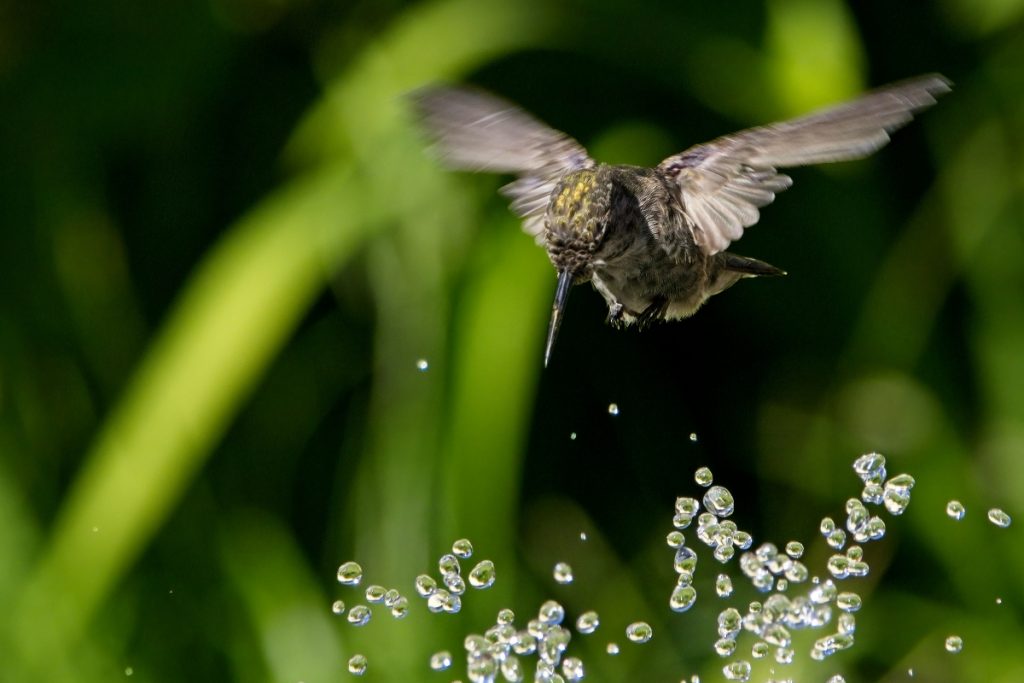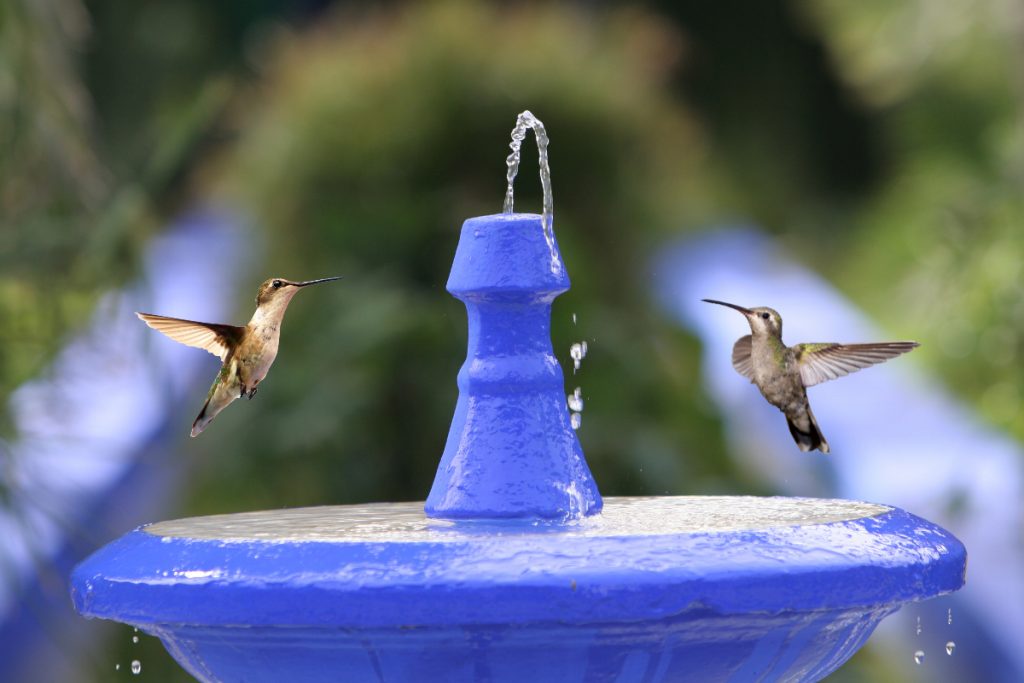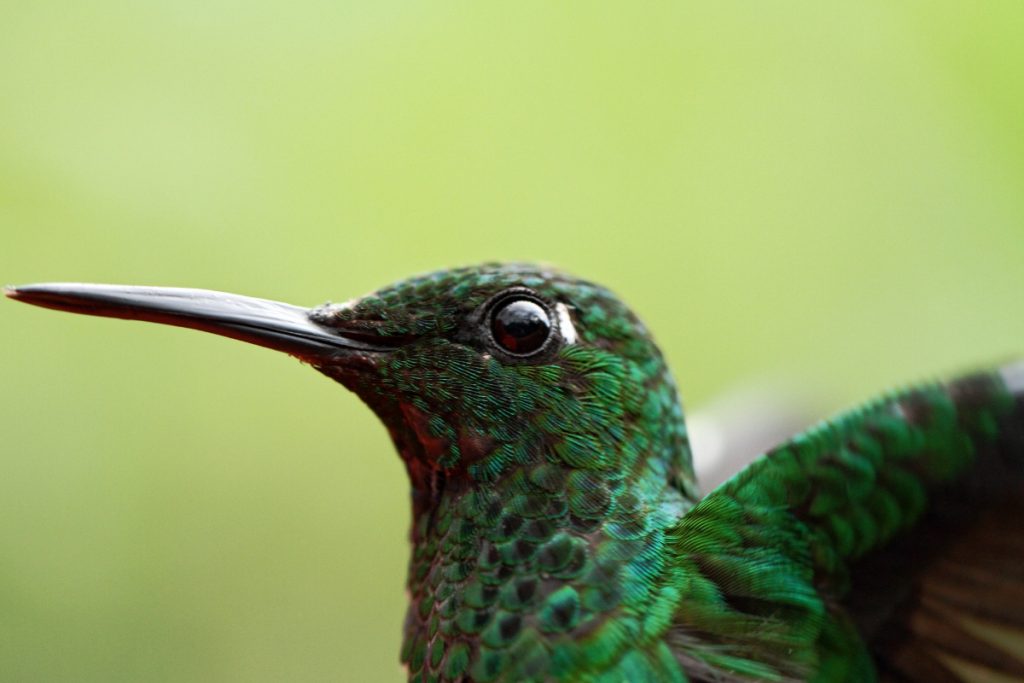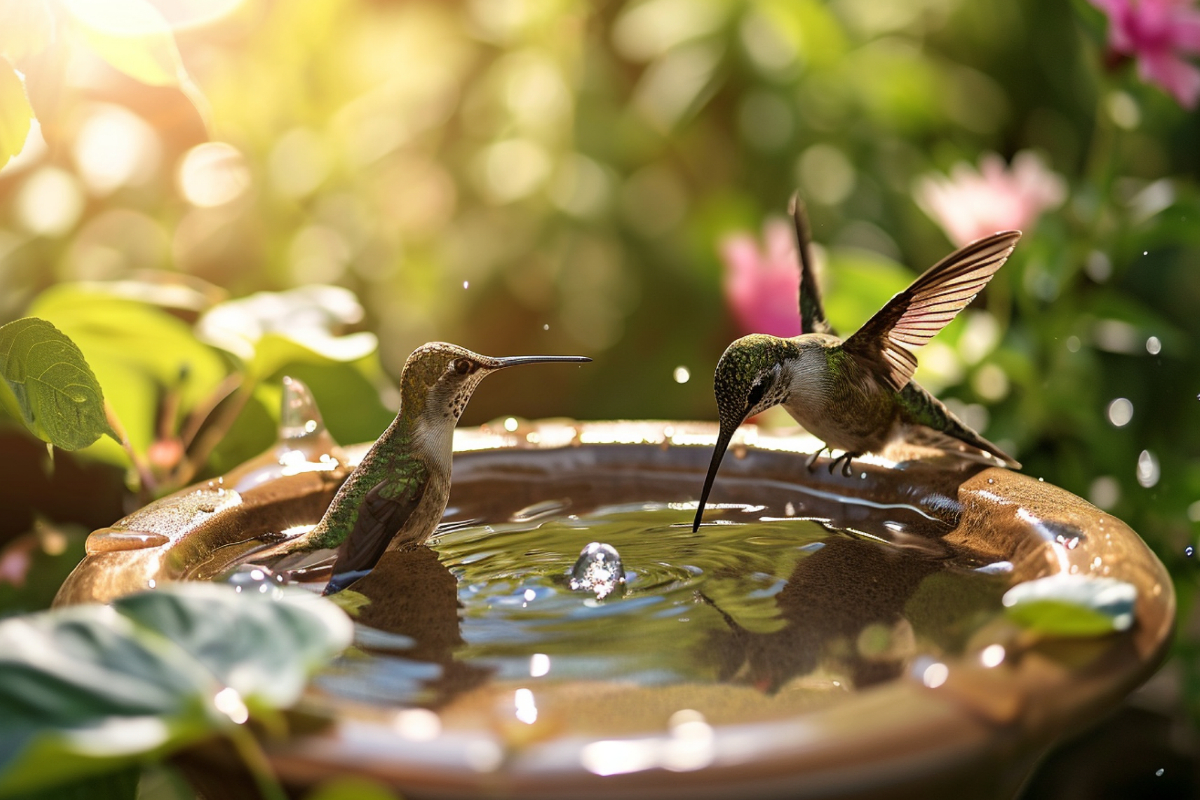Hummingbirds are captivating little birds, fluttering around with their glittering, iridescent feathers and long, slender beaks perfect for sipping nectar. Their beauty and energetic nature make them a joy to watch in our gardens.
But did you know that bathing plays a vital role in keeping hummingbirds looking and feeling their best?
In this blog post, we will explore why bathing is so crucial for hummingbirds and how you can create an enticing Oasis Birdbath to attract these birds.
Related post to read: 25 Hummingbird Behaviors That You May Not Know.

Why Do Hummingbirds Bathe?
Hummingbirds have very unique bathing habits compared to other birds. They do not submerge themselves fully in water or splash around. Instead, hummingbirds prefer to flutter through a fine mist or skim just the surface of minor-depth water.
Bathing serves several crucial functions for hummingbirds:
- Grooming: Bathing helps hummingbirds groom their feathers and keep them in prime flying condition. They carefully preen each feather to realign barbules and remove anything that could impede their aerodynamic flight.
- Oil distribution: As they preen, hummingbirds spread oil secreted from their preen gland evenly across their feathers. This oil helps waterproof and protect their feathers.
- Cooling down: Bathing can also help hummingbirds cool off on hot summer days, in addition to drinking and perching in shady spots.
- Parasite removal: Bathing washes away feather mites and other parasites that can be problematic if allowed to accumulate.
So, while hummingbirds get most of their hydration from flower nectar and feeders, bathing meets other essential needs for their health and feather maintenance. Providing a good bird bath can be vital for their well-being.

What Kind of Birdbath Do Hummingbirds Prefer?
Hummingbirds have very particular preferences when it comes to birdbaths compared to other backyard birds:
- Shallow water: Traditional deep bird baths don’t work for tiny hummingbirds. They need water just deep enough to wet their feet and bellies (1-2 inches).
- Moving water: The sight and sound of moving water, like from a mister, fountain, or dripper, attracts hummingbirds. They seem to especially enjoy flying through the mist.
- Open, elevated location: Hummingbirds feel more secure bathing where they can clearly watch for predators, not hidden amongst plants or foliage.
- Bright colours around it: Vibrant flowers, feeders, or decorations around the birdbath will catch their eye and invite them to explore.
- Fresh, clean water: Hummingbirds avoid baths with dirty, stagnant water, so changing it out frequently is a must.
Making a few simple modifications to your birdbath with these preferences in mind can transform it into an enticing hummingbird spa!

5 Tips for Creating an Ideal Hummingbird Birdbath
If you want to successfully attract hummingbirds to a new or existing bath, keep these handy tips in mind:
1. Add rocks, pebbles or marbles.
The easiest way to create shallower sections of water is to add rocks, pebbles, marbles or other small objects. Group them together to form pools 1-2 inches deep for safe hummingbird bathing.
2. Incorporate drippers, misters or fountains.
Consider adding a mister, dripper or small fountain for the sight and sound of moving water that will catch a hummingbird’s attention from a distance.
3. It’s better positioned around food sources.
Hummingbirds are most likely to notice and investigate a birdbath located conveniently close to their existing food sources, like nectar feeders or flower beds.
4. Provide bright colours around it.
Paint the bath a bright colour or surround it with bold flowering plants, fabrics or artwork to make the area pop. Red is particularly eye-catching to hummingbirds.
5. Change the water frequently.
Dump out dirty bath water and refresh it with clean water every 2-3 days, or more often in hot weather. This keeps it fresh and appealing.
When and Where Should I Put Out My Hummingbird Birdbath?
Spring and summer are the best times to put out a birdbath for hummingbirds in most regions when they are most active and populations peak. However, in warmer climates like the southern U.S., hummingbirds may use birdbaths year-round if the weather allows.
Ideally, place your hummingbird bath:
- Position the birdbath in an open area with good sightlines to watch for danger during vulnerable bathing times.
- Preferably close to existing food sources and resting spots like trees and feeders so, it’s easy to access.
- In a consistently sunny spot so, the water stays warmer as hummingbirds prefer.
- On a solid, level surface or, hang it for stability since hummingbirds hover right at the water’s surface.
Positioning your birdbath thoughtfully will maximise hummingbird visitors and bathing activity!

Wonderful Water Features to Try
From simple pie tin setups to elaborate cascading fountains, there are endless creative birdbath styles to try that will attract hummingbirds. Here are just a few favourite ideas:
- Mister: Hook up an inexpensive mister kit and let hummingbirds fly through the mist!
- Fountain: A small solar-powered fountain creates pleasant trickling water sounds.
- Dripper: Add a dripper or two so droplets form on the surface.
- Rain chain: Hang a decorative rain chain into a shallow basin for a beautiful dripping effect.
- Oasis: Plant bright flowers all around an open terra cotta saucer filled with pebbles and just enough water to wet them.
The options are endless! Observe what water features hummingbirds gravitate towards in your yard, and have fun experimenting!
Final Thoughts
In closing, bathing serves many vital functions for hummingbirds beyond just getting clean. As they flutter through mist and skim across shallow baths, hummingbirds care for their delicate feathers, distribute protective oils, cool down, and rid themselves of pesky parasites.
Supporting these behaviours by providing an enticing oasis filled with their preferred features will benefit the hummingbirds visiting your yard.
With a basic understanding of what attracts hummingbirds to water features and how to cater to their needs, you’ll be rewarded with a beautiful new source of entertainment, watching them hover, preen and play in their new birdbath paradise.
So grab some pebbles and a pie tin and see who shows up! And remember to keep that water fresh and inviting!
I hope you’ve discovered something new and interesting about the bathing habits of hummingbirds! Let me know if you have any other questions in the comments. Happy bathing, little hummers!
Useful Links:
Related Posts to Read:
- Do Hummingbirds Beaks Open When Feeding?
- The Mysteries of Hummingbird Flight.
- 6 Fascinating Facts About Hummingbird Sizes.
- Ruby-Throated Hummingbird Migration Map.
- Where Do Hummingbirds Go When It Rains?
- How Much Does A Hummingbird Eat Per Day?
- Hummingbird Diet and Nutrition.
References:
- About Hummingbird (Link).
- Greenewalt, C. H. (1960). Hummingbirds. New York: Doubleday. Google Scholar.
- Carey C. The impacts of climate change on the annual cycles of birds. Philos Trans R Soc Lond B Biol Sci. 2009 Nov 27; 364(1534):3321-30. doi: 10.1098/rstb.2009.0182. PMID: 19833644; PMCID: PMC2781852.
- Rico-Guevara A, Rubega MA, Hurme KJ, Dudley R. Shifting Paradigms in the Mechanics of Nectar Extraction and Hummingbird Bill Morphology. Integr Org Biol. 2019 Jan 2;1(1):oby006. doi: 10.1093/iob/oby006. PMID: 33791513; PMCID: PMC7671138.
- Tyrrell LP, Goller B, Moore BA, Altshuler DL, Fernández-Juricic E. The Orientation of Visual Space from the Perspective of Hummingbirds. Front Neurosci. 2018 Jan 30;12:16. doi: 10.3389/fnins.2018.00016. PMID: 29440985; PMCID: PMC5797624.
- Hummingbirds Sighting (Journey North Map).
- About Hummingbird’s Characteristics.
